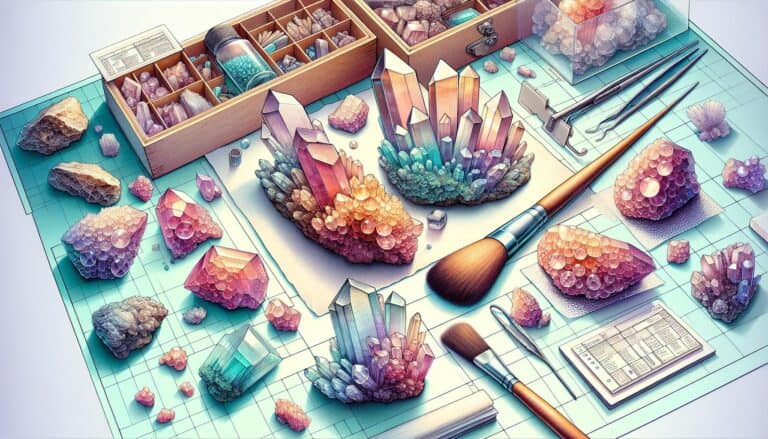Ready to uncover Earth’s hidden treasures in the Empire State?
Rockhounding in New York isn’t just for the pros; it’s a thrilling adventure you can dive into. With its diverse geological landscape, New York offers a bounty of spots where you can find your own piece of natural history.
New York’s rockhounding offers Herkimer diamonds in Herkimer County, garnets at Barton Garnet Mines, and fossils in Lewis County. Key tips include obtaining access permission, using safety gear, and consulting guidebooks for responsible and fruitful rockhounding.
New York Rockhounding Locations
Embarking on a rockhounding journey in New York, you’ll discover an array of locations teeming with geological wonders. Each site offers unique specimens, shaping an exciting quest.
Herkimer County is synonymous with the sought-after Herkimer diamonds – double-terminated quartz crystals with brilliant clarity. These gemstones aren’t true diamonds but are prized for their natural facets and exceptional hardness. Crystal Grove Diamond Mine and Herkimer Diamond Mines are two popular spots where you can try your luck at unearthing these shiny treasures.
Barton Garnet Mines in the Adirondack Mountains is another must-visit for rock enthusiasts. It’s home to some of the world’s largest garnet deposits. At the Gore Mountain mine, you have the rare opportunity to collect garnet crystals directly from the exposed rock face, where they often occur in impressive sizes.
In Lewis County, the Tug Hill region is well-known for its abundance of fossils, including trilobites and brachiopods, a testament to the area’s ancient marine past. Visit areas like Lowville for a chance to add some prehistoric finds to your collection.
- Herkimer County: Herkimer Diamonds
- Barton Garnet Mines: Garnets
- Lewis County: Fossils
Transitioning east, St. Lawrence County invites you to uncover diverse minerals such as wulfenite, celestine, and calcite. The Balmat-Edwards district is particularly rich in zinc minerals, with old mines occasionally open to the public for exploration.
Always remember to seek permission if you’re venturing onto private land or to adhere to the regulations of public sites. Safety gear is a must, and a good guidebook can enhance your experience by providing detailed information on what to look for and how to identify it. Keep an eye out for local rockhounding clubs or guided tours, which can provide valuable insight and add a layer of camaraderie to your adventure.
What Gemstones are Found in New York?

Exploring the hidden treasures of New York, you might wonder which gemstones you can add to your collection. The state is a cornucopia of gemstone variety, each with its own unique lure.
Herkimer Diamonds are arguably the most famous gemstone found in New York. Despite their name, these are actually double-terminated quartz crystals that resemble diamonds due to their clarity and natural faceting. These stones are so renowned that they have been designated as the official mineral of New York State.
Beyond the glittering allure of Herkimer diamonds, New York is a haven for garnet enthusiasts. The Barton Garnet Mines in the Adirondack Mountains are historically significant and still offer garnets that are among the largest in the world. The New York garnet has earned its prestige not only for its size but also for its deep red hue which is sought after by both jewelers and collectors.
In addition to quartz and garnets, the Empire State is rich with other collectible minerals that can be cut and polished into beautiful gemstones. Within the diverse geology of New York, you can find:
- Sapphire
- Tourmaline
- Zircon
- Moonstone
Make sure to do your research as some of these gemstones can be found only in specific locations. For example, the Adirondack Mountains are known for their sapphire and tourmaline deposits, offering a unique opportunity for rockhounds to unearth something truly special.
As a rockhound in New York, you’re also likely to stumble upon a variety of other semi-precious stones. With a keen eye and a bit of luck, you can discover:
- Beryl
- Topaz
- Agates
- Chalcedony
The discovery of these gemstones often involves digging through hard rock, so be prepared with the right tools for the job. Remember to always respect the land and its regulations, ensuring that the beauty and availability of these natural resources remain for years to come.
What Sedimentary Rocks You Can Find in New York?

When exploring the diverse geologic landscape of New York, you’ll be intrigued to find an array of sedimentary rocks. These rocks, formed by the accumulation and compaction of sediment, often tell a story of New York’s ancient environments.
Shale is prevalent and can be found in the Southern Tier of New York. Known for its fine grain and layered appearance, shale offers insights into the past marine environments. This sedimentary rock, typically gray, brown, or black, reveals the Earth’s history through the fossils it often contains.
In addition to shale, the state is also home to astonishing limestone formations. Replete with fossils from ancient sea creatures, limestone in New York is primarily located in regions like the Hudson Valley and the Finger Lakes. These areas were once part of a shallow sea, and the limestone here is a sedimentary canvas that captures that prehistoric marine life.
Sandstone, such as the Potsdam Sandstone in northern New York, is another significant feature of the state’s geology. The Potsdam Sandstone, notable for its red and brown hues, forms some of New York’s most dramatic landscapes.
- Shale: Southern Tier
- Limestone: Hudson Valley, Finger Lakes
- Sandstone: Northern New York (Potsdam)
Fossil hunters and geological enthusiasts revel in the presence of these rocks, keen to uncover relics of the past. As with gemstone rockhounding, when searching for sedimentary rocks, be sure you’re aware of the local laws and regulations. Always seek permission for private land and adhere to the guidelines set out by state parks or public lands.
Sedimentary rocks in New York not only provide a portal to the past but also offer a hands-on educational experience. Whether you’re a seasoned rockhound or a curious beginner, the sedimentary layers of New York’s terrain harbor untold stories awaiting your discovery.
What Metamorphic Rocks are found in New York?
When on the hunt for metamorphic rocks in New York, you’ll be delighted by the variety this state offers. Slate, schist, and gneiss are some of the most common metamorphic rocks you’ll come across. Found throughout the state, they’re particularly prevalent in the Hudson Highlands and the Adirondack Mountains.
- Slate is often sought after for its fine grain and durability. It’s primarily used in construction, arts, and crafts. In its natural environment, slate often signifies ancient seabeds that have transformed over millions of years.
- Schist, characterized by its glittering appearance due to mica content, can range in color from silvers to lush greens, with each piece holding a unique blend of minerals.
- Gneiss has distinct banding and is often used as a decorative stone.
Given the geological diversity of New York, you may also come across other interesting metamorphic rocks such as:
- Marble, particularly in the Gouverneur region, which is a result of limestone subjected to heat and pressure.
- Quartzite, which can be found in the spectacular high peaks of the Adirondacks, presents a challenge for rockhounds but offers a rewarding find.
Always remember that each rockhounding trip requires preparation. Ensure you’re equipped with the proper tools and understanding of the terrain. Research on your chosen location is essential since not only will it make your search more successful, but it’ll also protect you from trespassing on private property.
Metamorphic rocks, with their power to recount Earth’s dynamic changes, can take your rockhounding adventure from a simple hobby to an immersive learning experience. They lay bare the intense pressures and temperatures that have shaped the region’s landscapes. As you uncover these geological treasures, you’re uncovering part of New York’s deep-rooted history.
What Igneous Rocks can You Find in New York?
When searching for igneous rocks in New York, you’re in for a volcanic treat. The state’s geologic history has blessed it with an incredible variety of these rocks, formed from the cooling and solidification of magma or lava.
New York’s igneous rocks mainly stem from ancient volcanic activity. One of the most coveted finds is granite, which is not only widespread in construction projects but also a prized collectible for its unique mineral configurations. In the Adirondacks, massive granite formations provide ample hunting grounds for different types of this igneous rock. You might come across varieties such as:
- Pink granite
- Gray granite
- Biotite granite
Basalt is another find to add to your list, with the Palisades Sill, along the Hudson River, being a notable location. Rocks from this sill are remarkable for their columnar jointing, created as the thick lava cooled slowly and evenly.
The diversity doesn’t stop there. In the northeastern parts of the state, close to the border with Vermont, you can find syenite and anorthosite, which are less common but highly interesting due to their distinctive textures and compositions.
For those with a keen eye, smaller specimens like pegmatite, notable for containing large crystals, can be uncovered. This coarse-grained rock often hosts a variety of valuable minerals, including:
- Quartz
- Feldspar
- Mica
Always remember to respect property boundaries and seek permission when necessary. Rockhounding involves a lot of digging and can quickly become a physically demanding activity, so ensure you’re prepared with the proper tools and attire.
By embracing the thrill of the hunt and exercising due diligence, you’re set to uncover the fiery past of New York’s igneous rocks. The treasure trove beneath your feet awaits, ready to reveal secrets from deep within the Earth’s crust.
Panning for Gold in New York
If you’re bitten by the gold fever, New York might be a surprising spot to sate your thirst for treasure hunting. While it’s not often publicized, New York State does have gold, and panning for it can be one of the most exciting parts of your rockhounding adventure.
You’ll find potential in spots such as the Southern Tier and parts of the Adirondacks, where glacial deposits have left behind some placer gold. The Ausable River, in particular, is known for fine gold deposits. Imagine the rush of uncovering specks of gold from the river’s sediment, the same way prospectors did centuries ago.
Key Locations for Panning
- Creeks in Madison County – These creeks have reports of fine gold flakes.
- St. Regis Falls in Franklin County – Here, the water flow brings down gold from erosion upriver.
- Raquette River – Gold has been spotted intermittently in the gravels banks.
Before setting out, get a grasp on the local regulations. Permits may be required for panning in state-owned lands and always obtain permission when attempting to pan on private property. This due diligence ensures you’re not infringing on any laws or rights.
Techniques That Work Best
When you hit the rivers or creeks, start with these tips:
- Use a pan with ridges to effectively trap gold flakes.
- Standing in knee-deep water, swirl your pan in a circular motion to separate the heavy gold from lighter sand and gravel.
- Remember, patience is everything. Panning is a meditative art as much as a skill.
Don’t overlook the right gear. Waterproof boots, a pair of gloves, and a sturdy pan can make your experience far more comfortable and productive. Bring along a magnifying glass; sometimes the gold particles are minuscule but still thrilling to find.
With a little persistence and a keen eye, you might just find that New York’s rivers hold more than just clear waters – they could conceal flashes of gold, waiting to be discovered by determined rockhounds like yourself. Keep in mind, responsibility and respect for the environment are paramount—leave no trace of your adventure, other than the memories and perhaps a small vial of golden flakes.
Rocks and Minerals Found in New York
As you delve into the rich tapestry of New York’s geology, you’ll find a variety of rocks and minerals that would add diversity and value to your collection. The state is known for its extensive mineral deposits, offering rockhounds the thrill of discovery with every excursion.
New York’s most sought-after minerals include garnet, which is the state’s official gemstone. Barton Mines in the Adirondacks is famous for producing some of the world’s highest quality garnets. You’re also likely to encounter quartz varieties such as herkimer diamonds—exceptionally clear and naturally faceted crystals found in and around Herkimer County.
Here’s a snapshot of what’s up for grabs:
- Garnet – particularly in the Gore Mountain region
- Herkimer Diamonds – near Herkimer, Middleville, and Little Falls
- Calcite and Dolomite – common in many locations throughout the state
- Pyrite and Marcasite – offering metallic luster to your finds
For those with a passion for fossils, the Devonian-aged rocks of Central New York are brimming with ancient marine life such as trilobites, corals, and brachiopods. Searching these areas can result in finding fossilized remnants that are over 350 million years old!
While exploring, keep in mind that different regions yield different treasures:
- Adirondack Mountains – known for garnet and wollastonite
- Mohawk Valley – abundant in quartz crystals, including herkimer diamonds
- Hudson Highlands – a good location for sphalerite and emerald
Remember to be equipped with the proper tools for a successful and safe rockhounding trip—safety glasses, gloves, and sturdy footwear are essentials. Bring along a field guide to help identify finds, and as always, make sure you’re abiding by the legalities of rock collecting.
New York offers more than just magnificent skylines—it’s home to an impressive collection of natural history beneath your feet. Whether you’re an experienced rockhound or a curious novice, the state keeps its secret wonders ready for those willing to look.
Where Can I Find Fossils in New York?
New York, a haven for fossil enthusiasts, boasts numerous sites where you can uncover remnants of ancient life. The quest to discover fossils may lead you to Central New York, often referred to as the state’s paleontological gold mine.
One prime location is Penn Dixie Fossil Park and Nature Reserve, located in Hamburg, mere minutes from Buffalo. This site is famous for its abundance of Devonian Period fossils. You’re able to keep the fossils you find, making it a delightful haven for collectors of all ages. Expect to uncover trilobites, brachiopods, and corals with varying levels of preservation.
18 Mile Creek, another iconic spot known for fossil-rich shale in the Lake Erie cliff faces, presents a slightly more challenging terrain for rockhounding. The creek’s erosion continually reveals fresh fossil-bearing rock, providing you with a good chance of finding gastropods, crinoids, and trilobite fragments.
In the heart of Central New York lies the Chittenango Falls State Park, where brachiopods and trilobites are waiting to be claimed by avid collectors. While rockhounding there, be sure to stay within the designated public access areas to comply with state regulations.
When planning your fossil-finding adventure, remember to:
- Check for any location-specific rules and guidelines
- Obtain necessary permits if required
- Use appropriate tools for excavating and cleaning fossils
For a detailed list of fossil sites in New York:
- American Museum of Natural History website
- New York State Geological Survey publications
- Local rockhounding clubs or forums
These resources provide invaluable information on site accessibility, fossil identification, and the latest discoveries in the state.
Exploring New York’s rich fossil locales, you’ll not only enjoy the thrill of the hunt but also gain a deeper appreciation of Earth’s prehistoric life. Each site offers a unique window into the distant past and contributes to the tapestry of New York’s geological history.
New York Rockhounding Laws & Regulations
Before packing your gear and heading out to any of the lucrative sites in New York, it’s crucial to understand the local laws and regulations governing rockhounding. Adhering to these rules ensures that you can enjoy your hobby without inadvertently breaking any laws.
Firstly, always obtain permission to collect on private property. Trespassing on private land without the owner’s consent is illegal and disrespectful to property owners. On state lands, collecting minerals, gems, or fossils is generally permissible. However, the Department of Environmental Conservation (DEC) restricts collecting in certain areas to protect the natural environment and historical sites.
Moreover, New York operates under the “Take Nothing but Pictures, Leave Nothing but Footprints” approach in many of its state parks. As a rule of thumb, do not remove any natural or cultural resources. This includes rocks, wildlife, and plants. If you’re unsure about the regulations of a specific area, check the DEC website or contact park authorities directly.
In national parks and natural landmarks, removal of any natural object is typically prohibited. Hence, familiarize yourself with the regulations specific to the federal land you’re exploring.
When it comes to fossicking for Herkimer diamonds, several commercial mines allow you to hunt for a fee. It’s advantageous to take this route as these sites are legally designated for rockhounding activities. However, ensure that you’re aware of each site’s regulations regarding equipment allowed and daily haul limits.
For your convenience, below are essentials to keep in mind:
- Always seek permission on private lands
- Verify collecting limitations on state and federal properties
- Review individual site regulations for commercial mines
- Heed the “Take Nothing but Pictures, Leave Nothing but Footprints” policy in sensitive areas
Remember, the joy of rockhounding comes with the responsibility of preserving our natural heritage. By following the rules, you help ensure that these treasures are available for future generations to enjoy.
Rockhounding Tips for Beginners in New York
Gearing Up: Essential Tools for Rockhounding
When you’re gearing up for a rockhounding adventure in New York, having the right tools is key to a fruitful and enjoyable experience. First and foremost, invest in a durable geologist’s hammer, which is crucial for chipping away at rock formations and extracting specimens. Next, a hand lens or magnifier will become your go-to for inspecting the details of your finds. Don’t forget to pack a sturdy pair of gloves to protect your hands from sharp edges and a hard hat to safeguard against falling debris.
For transporting your treasures, bring along collection bags or buckets, and label them if you’re visiting multiple sites. A field guide to rocks and minerals can also greatly enhance your understanding of potential discoveries. And since New York’s terrain can vary, it’s wise to have a set of chisels and a rock pick for more precise work.
- Geologist’s hammer
- Hand lens or magnifier
- Gloves
- Hard hat
- Collection bags or buckets
- Field guide
- Chisels and rock pick
Safety Tips While Rockhounding
Safety should always be your top priority when rockhounding. Make sure you’re wearing protective gear such as the gloves and hard hat mentioned earlier. In addition, it’s important to have appropriate footwear; rugged boots with good ankle support are best, especially when navigating rocky terrain.
Always tell someone your itinerary, including when you expect to return, in case you encounter any emergencies. Keep a first-aid kit and plenty of water with you to handle minor injuries and stay hydrated. Be mindful of the wildlife and plants – it’s not uncommon to come across poisonous plants or venomous snakes in some New York areas. Remember, never rockhound alone; bringing a buddy can not only be more fun but also much safer in case of an incident.
Legal Guidelines for Rockhounding Enthusiasts
You must be aware of and adhere to the legalities of rockhounding. Always obtain permission if you’re planning to explore private lands or areas that require permits. In New York, much of the land is privately owned, so don’t assume you can collect without checking first.
When on public land, be sure to know the regulations as they can vary widely. Some areas might allow for casual collection, while others, especially those deemed as scientific or historical sites, might be off-limits. Places like state parks often have strict “Take Nothing but Pictures, Leave Nothing but Footprints” policies. Being informed about the local laws and regulations prevents potential legal issues and ensures that rockhounding sites remain intact for others to enjoy.
Rockhounding can be a fantastic way to connect with nature and discover the geological wonders of New York. Equip yourself with the right gear, prioritize safety, and stay legal—a respectful and thoughtful approach can yield not just great finds but also a truly rewarding experience.
Conclusion: New York Rockhounding Locations
You’re now equipped with the knowledge to embark on a rockhounding adventure across New York’s diverse landscapes.
Remember, the key to a successful and enjoyable experience lies in preparation and respect for the environment. Armed with your tools and awareness of the regulations, you’re ready to uncover the geological wonders that await. So grab your gear, stay safe, and let the thrill of discovery guide you to New York’s hidden gems.
Happy rockhounding!







